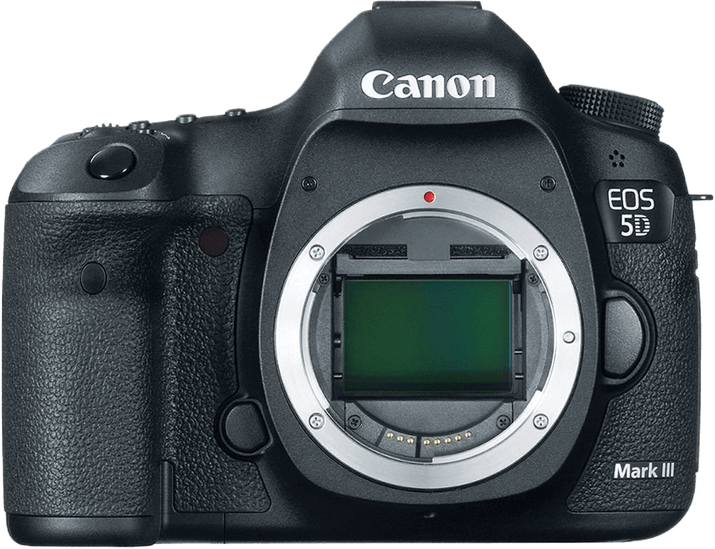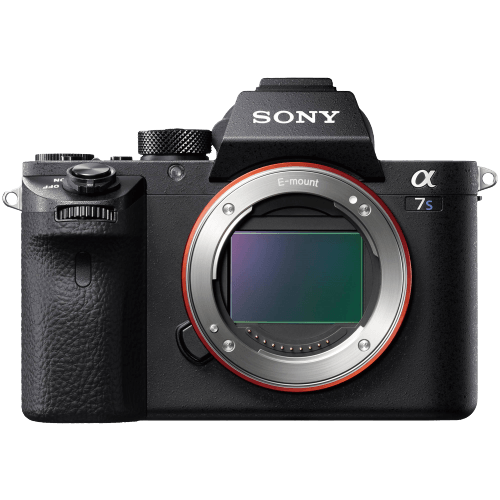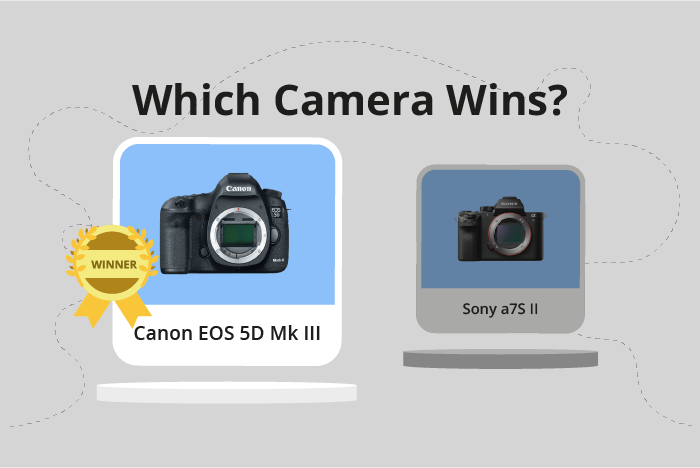Canon EOS 5D Mark III vs Sony a7S II Comparison
Canon EOS 5D Mark III

Sony a7S II

The Canon EOS 5D Mark III outperforms the Sony a7S II with a score of 65/100 compared to 60/100. Both cameras share some common specifications, such as being released in the early 2010s, with the Canon in 2012 and the Sony in 2015, and having similar launch prices of $3499 and $3000, respectively.
The Canon EOS 5D Mark III, a DSLR camera, has a larger size (152 x 116 x 76mm) and is heavier (950g) compared to the Sony a7S II, a mirrorless camera, with dimensions of 127 x 96 x 60mm and a weight of 627g. This difference in size and weight makes the Canon more robust and durable, while the Sony is more portable and lightweight.
Despite the lower score, the Sony a7S II still has its advantages, such as being more compact and easier to carry around. Choosing between these cameras depends on individual preferences and priorities, whether it’s durability and sturdiness or portability and convenience.
Canon EOS 5D Mark III vs Sony a7S II Overview and Optics
The Canon EOS 5D Mark III outperforms the Sony a7S II in optics with a score of 67/100 compared to the Sony’s 66/100. Both cameras have a CMOS sensor, a full-frame sensor size, and use their respective lens mounts: Canon EF for the 5D Mark III and Sony FE for the a7S II.
The 5D Mark III has a higher megapixel count at 22.3, compared to the a7S II’s 12.2 megapixels. This allows the Canon to capture more detail in images. Additionally, the 5D Mark III has a faster shooting speed of 6 frames per second, compared to the Sony’s 5 frames per second. This makes the Canon more suitable for capturing fast-moving subjects. The Digic 5+ processor in the 5D Mark III is also a strong point, contributing to its overall performance.
However, the Sony a7S II has a higher DXOMARK sensor score of 85, compared to the Canon’s 81. This means the Sony’s sensor performs better in terms of dynamic range, color depth, and low-light capabilities. The a7S II also has built-in image stabilization, which the 5D Mark III lacks. This feature helps reduce camera shake, resulting in sharper images.
Taking these factors into account, the Canon EOS 5D Mark III has advantages in megapixel count, shooting speed, and processing power, making it a strong choice for detailed images and fast-paced photography. On the other hand, the Sony a7S II excels in sensor performance and image stabilization, making it a better option for low-light situations and handheld shooting.
Canon EOS 5D Mark III vs Sony a7S II Video Performance
The Sony a7S II and the Canon EOS 5D Mark III have a tie in video scores, both achieving a 56/100. Despite the identical scores, each camera has its strengths and weaknesses in video capabilities.
Both cameras lack built-in time-lapse functionality. However, the Sony a7S II surpasses the Canon EOS 5D Mark III in terms of maximum video resolution, offering 4K (3840 x 2160) compared to the Canon’s Full HD (1920 x 1080). This means that the Sony a7S II can produce videos with higher detail and clarity.
On the other hand, the Canon EOS 5D Mark III has an advantage in maximum video frame rate, reaching 60fps, while the Sony a7S II can only achieve 30fps. This higher frame rate allows the Canon to capture smoother and more fluid motion in videos, particularly useful for fast-moving subjects or slow-motion effects.
In conclusion, the Sony a7S II excels in video resolution, providing 4K quality for more detailed and visually impressive videos. Conversely, the Canon EOS 5D Mark III offers a higher frame rate, delivering smoother motion capture. Both cameras have their unique benefits, and the choice between them will depend on the specific video requirements of the user.
Canon EOS 5D Mark III vs Sony a7S II Features and Benefits
The Canon EOS 5D Mark III wins in the features comparison with a score of 59/100, while the Sony a7S II scores 57/100. Both cameras share some common specifications, such as the lack of a touchscreen, GPS, and Bluetooth.
The Canon EOS 5D Mark III has a larger screen size, measuring 3.2 inches compared to the Sony a7S II’s 3-inch screen. However, the Sony a7S II has a higher screen resolution, with 1,228,800 dots compared to the Canon’s 1,040,000 dots. Despite the difference in resolution, the larger screen size of the Canon EOS 5D Mark III provides a better viewing experience.
The Sony a7S II outshines the Canon EOS 5D Mark III in two aspects: it has a flip screen and built-in Wi-Fi. The flip screen allows for more versatile shooting angles, which is especially useful for videographers. The built-in Wi-Fi enables easy image transfer and remote control of the camera using a smartphone or tablet.
While both cameras have their strengths and weaknesses, the Canon EOS 5D Mark III’s larger screen size gives it an edge over the Sony a7S II. However, the Sony a7S II’s flip screen and Wi-Fi capabilities make it a more versatile option for those who value flexibility in shooting and connectivity. Each camera excels in different areas, and the choice depends on the specific needs and preferences of the photographer.
Canon EOS 5D Mark III vs Sony a7S II Storage and Battery
The Canon EOS 5D Mark III outperforms the Sony a7S II in storage and battery, scoring 76/100 compared to Sony’s 21/100. Both cameras accept SD/SDHC/SDXC memory cards, but the Canon 5D Mark III also supports Compact Flash and UDMA, while the Sony a7S II accommodates Memory Stick Duo/Pro Duo/Pro-HG Duo. Additionally, the Canon 5D Mark III has two memory card slots, compared to the Sony a7S II’s single slot.
In terms of battery life, the Canon 5D Mark III is superior with 950 shots per charge, using the LP-E6 battery type. The Sony a7S II, on the other hand, only offers 370 shots per charge with its NP-FW50 battery. Neither camera has USB charging capabilities.
The Canon EOS 5D Mark III clearly outshines the Sony a7S II in the storage and battery department, offering greater memory card compatibility, an extra memory card slot, and significantly longer battery life. The Sony a7S II does not have any advantages in this category. These differences make the Canon 5D Mark III the better choice for extended shooting sessions and flexibility in storage options.
Canon EOS 5D Mark III vs Sony a7S II – Our Verdict
Are you still undecided about which camera is right for you? Have a look at these popular comparisons that feature the Canon EOS 5D Mark III or the Sony a7S II:

